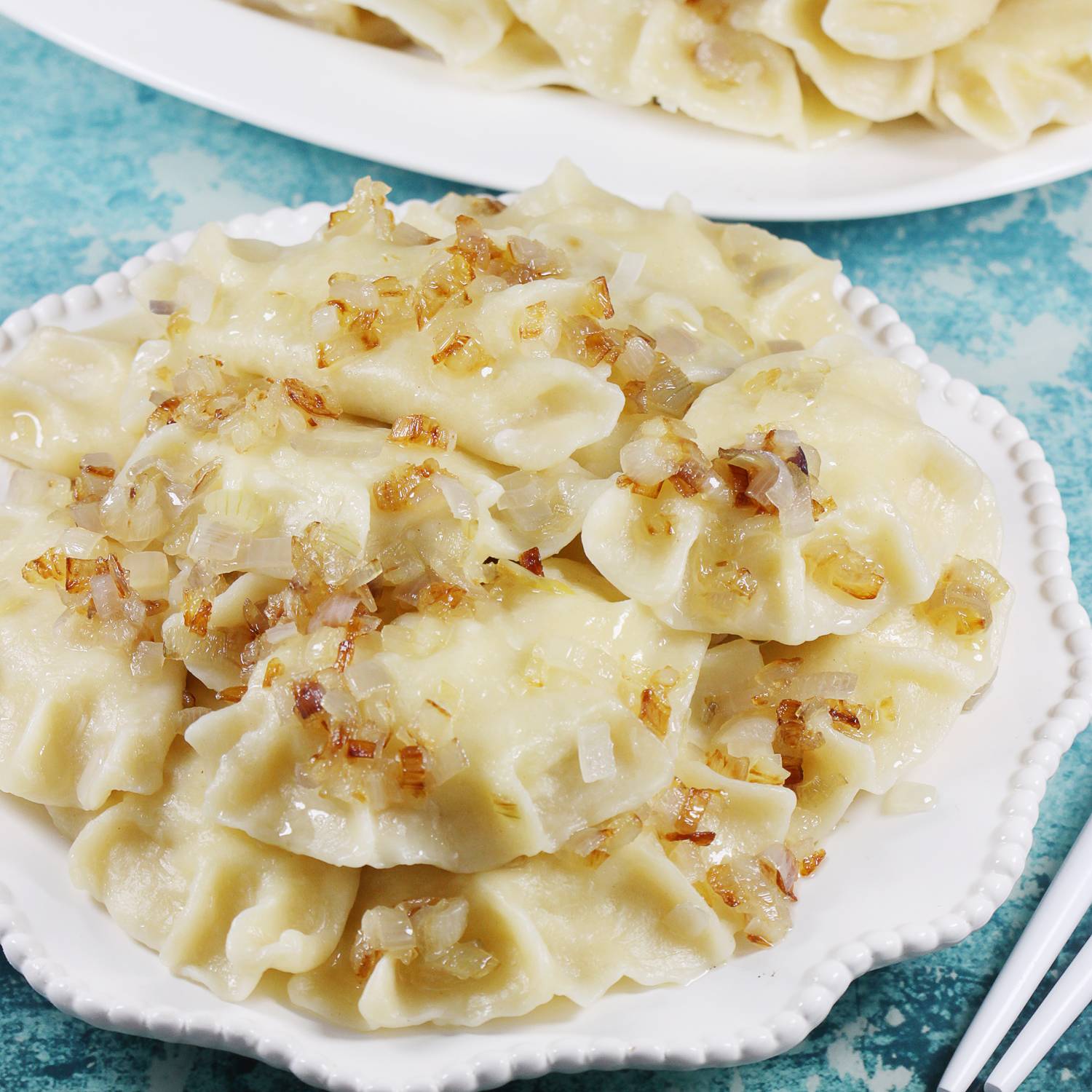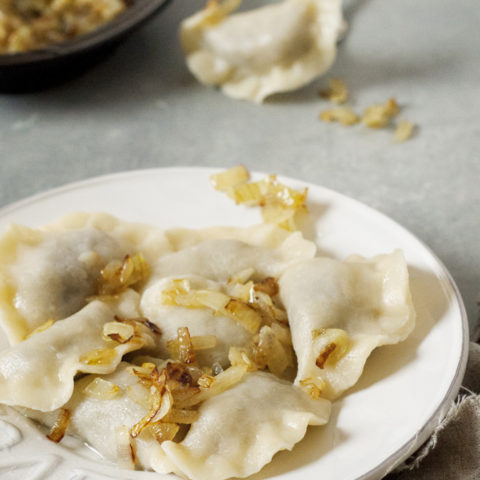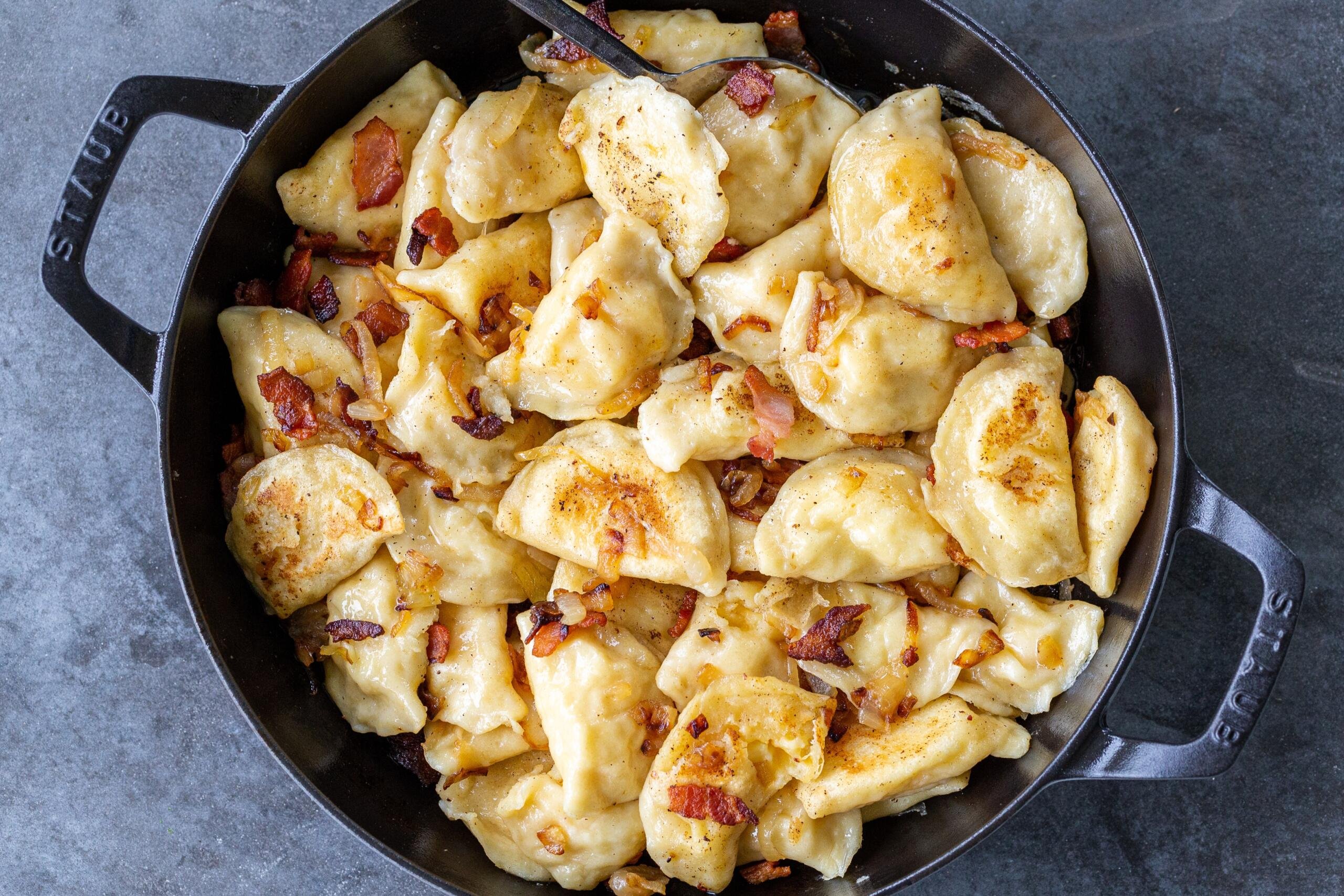Pierogi Ruskie (Authentic Potato and Cheese Pierogi) + video
5.0
(9)
Your folders
Your folders
Prep Time: 120 minutes
Cook Time: 15 minutes
Total: 135 minutes
Servings: 6
Author : Aleksandra

Ingredients
Export 6 ingredients for grocery delivery
Instructions
Step 1
Add the flour and salt into a large bowl, and stir together.
Step 2
In a small saucepan, warm the water with butter until they are very hot, but not boiling (temperature should be around 80-90 °C / 176-194 °F, that is when the water starts to move and steam).
Step 3
Pour hot water with butter into the bowl with flour. Stir with a wooden spoon until roughly combined.
Step 4
Knead the dough using your hands or with a stand mixer fitted with a hook attachment, for about 5 minutes. A food processor can also be used (fitted with the dough blade). The dough should be smooth, soft, and elastic, it shouldn’t stick to your hands. When you follow the recipe (especially if you weigh the ingredients, instead of using measuring cups), the dough should be perfect, but if for some reason it’s not, add some water if it’s too dry, or a little bit of flour if it’s too wet. If the dough already forms a ball, is relatively smooth, but still tough, it means that it’s not ready, it must be further kneaded until soft and elastic (after resting time it will be even softer).
Step 5
Wrap the kneaded dough in plastic foil (so it doesn’t dry out), and leave to rest for about 30 minutes (it will be easy to roll out).
Step 6
Boil the potatoes in a pot of salted water until soft enough to mash. Drain and mash the potatoes, transfer to a large bowl, and set aside to cool.
Step 7
Dice the onions. Heat the oil in a large frying pan, and cook the onions over medium-low heat for about 10 minutes until translucent.
Step 8
Combine the potatoes with cheese and onions, and season with salt and pepper to taste. You can do it with your hands or with a stand mixer (fitted with a flat beater attachment) or with a potato press (I have a blender with a potato masher attachment, it‘s great here).
Step 9
Optional step: You can form the filling into balls – making the pierogi goes faster this way. This method is not great for every pierogi filling, but in this case, it’s perfect. I scoop the filling with an ice cream scoop, then divide it in half and form a ball, each about 1 1/2 inches (3.5 cm) in diameter, about 0.7 oz (20g) in weight. You can, of course, scoop the filling with a teaspoon – about 1 teaspoon for 1 pieróg. If the filling is not easy to form you can put it in the fridge for 30 mins.
Step 10
Divide the dough into 4 parts.
Step 11
On a lightly floured surface, thinly roll out the first piece of the dough, to a thickness of approx. 1/16 inch (2 mm). If the dough is hard to roll out, set it aside for about 5-10 minutes to rest.
Step 12
Use a cup or a pierogi/pastry cutter to cut out rounds. (I also get a lot of questions about the pierogi cutter that is shown on the photos, it’s very old and 2 3/4 inches (7cm) in diameter!). Gather the scraps, cover them with plastic wrap, and set aside.
Step 13
Place one ball of filling (about 1 heaped teaspoon) on each round.
Step 14
Fold the dough over the filling to create a half-moon shape. Press edges together, sealing and crimping with your fingers. Do not leave any gaps or pierogi may open during cooking. Optional: You can make a decorative edge – it’s shown in the video.
Step 15
Place the pierogi apart on a floured surface and cover them loosely with a kitchen cloth so they don‘t dry out.
Step 16
Repeat with the remainig dough.
Step 17
Bring a large pot of salted water to a boil.
Step 18
Cook the pierogi in batches (for a 21 cm /8-inch pot I cook about 10-12 dumplings at a time). When they float to the water surface cook them for 1-2 minutes, then remove from the water with a slotted spoon. The cooking time will depend on the thickness of the dough.
Step 19
Drain well and transfer to a plate or baking sheet. Pour melted butter over pierogi so they don’t stick to each other.
Step 20
Enjoy!
Top similar recipes
Curated for youYour folders

 426 views
426 viewsPierogi Ruskie (Potato and Cheese P...
cooking.nytimes.com
5.0
(849)
Your folders

 192 views
192 viewsPierogi Ruskie: Potato and Cheese P...
annainthekitchen.com
10 minutes
Your folders

 181 views
181 viewsPierogi ruskie
sbs.com.au
45 minutes
Your folders

 358 views
358 viewsPierogi ruskie | AniaGotuje.pl
aniagotuje.pl
4.8
5
Your folders

 32 views
32 viewsPolish Potato & Cheese Pierogi ...
polonist.com
4.6
(26)
20 minutes
Your folders
/20220303-pierogi-vicky-wasik-57-ebc147e5870e4544add8cd880f75125c.jpg)
 336 views
336 viewsPotato and Cheese Pierogi
seriouseats.com
Your folders

 76 views
76 viewsPotato and Cheese Pierogi
saveur.com
Your folders

 240 views
240 viewsMy Grandma's Pierogi Ruskie Recipe
polishfoodies.com
4.7
(18)
Your folders
 238 views
238 viewsCheese Pierogi
foodnetwork.com
2 hours, 10 minutes
Your folders

 255 views
255 viewsPierogi ruskie wg przepisu z 1920r.
przepisytradycyjne.pl
25
Your folders

 173 views
173 viewsAuthentic Polish Pierogi Recipe
annainthekitchen.com
4.4
(13)
5 minutes
Your folders

 145 views
145 viewsPotato and cheese pierogi the Ameri...
everyday-delicious.com
5.0
(4)
20 minutes
Your folders

 272 views
272 viewsBlueberry Pierogi Recipe (VIDEO)
natashaskitchen.com
5.0
(42)
10 minutes
Your folders

 359 views
359 viewsThe Classic Pierogi (Potato and Che...
momsdish.com
4.9
(353)
20 minutes
Your folders

 233 views
233 viewsPierogi
lovebakesgoodcakes.com
30 minutes
Your folders

 339 views
339 viewsPierogi
noblepig.com
5.0
(42)
40 minutes
Your folders

 247 views
247 viewsBroccoli & cheese pierogi
jamieoliver.com
Your folders

 132 views
132 viewsSweet Cheese Pierogi
everyday-delicious.com
5.0
(3)
15 minutes
Your folders

 193 views
193 viewsAuthentic Polish Pierogi with Potat...
eatingeuropean.com
4.9
(23)
30 minutes